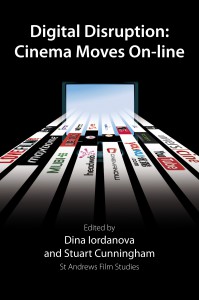Digital Disruption: Cinema Moves On-line edited by Dina Iordanova and Stuart Cunningham (St Andrews Film Studies, 2012). 223 pages. ISBN 9780956373076 (paperback) £19.99.
 About the author: Dr William Brown is Senior Lecturer in Film at the University of Roehampton, London. He is the author of Supercinema: Film-Philosophy for the Digital Age (Berghahn, 2013) and, with Dina Iordanova and Leshu Torchin, of Moving People, Moving Images: Cinema and Trafficking in the New Europe (St Andrews Film Studies, 2010). He is also the co-editor, with David Martin-Jones, of Deleuze and Film (Edinburgh University Press, 2012). He has published essays in various edited collections and journals. He is also a filmmaker, with three completed features that have played at various venues and film festivals in Europe and North America.
About the author: Dr William Brown is Senior Lecturer in Film at the University of Roehampton, London. He is the author of Supercinema: Film-Philosophy for the Digital Age (Berghahn, 2013) and, with Dina Iordanova and Leshu Torchin, of Moving People, Moving Images: Cinema and Trafficking in the New Europe (St Andrews Film Studies, 2010). He is also the co-editor, with David Martin-Jones, of Deleuze and Film (Edinburgh University Press, 2012). He has published essays in various edited collections and journals. He is also a filmmaker, with three completed features that have played at various venues and film festivals in Europe and North America.
Digital Disruption offers a series of essays on how film exhibition is undergoing an increasing shift away from movie theatres and into the online world. It is divided into three sections: Digital Disruption, Cinema Moves On-line and Resources.
The book features five essays that each look at various aspects of how the internet has changed the face of cinema. Dina Iordanova looks at how the internet has affected global film circulation; Stuart Cunningham and Jon Silver provide a history of online film distribution; Michael Gubbins considers the changed relationship between audiences and films as a result of the internet; Michael Franklin discusses the way in which the internet has modified the film value chain; and Marijke de Valck analyses the way in which the internet is being incorporated into the film festival circuit.
The second section provides case studies of various prominent websites that contribute to film culture, either directly as distribution/exhibition channels (key examples being Jaman and MUBI), or more generally (the Internet Movie Database; the festival submission website Withoutabox). The section is rounded off with an essay by Ben Slater about how the internet has enabled alternative forms of cinephilia that extend beyond the movie theatre/picture house.
Finally, the Resources section provides information about the timeline of online distribution, about online video-on-demand (VOD) providers, how they rank in terms internet traffic, what deals those providers have struck with content providers, and related online resources.
 Given the contents of Digital Disruption, it is safe to say there is much of use in this book, in particular the first three essays by Iordanova, Cunningham and Silver and former Screen International editor Michael Gubbins. The industrial approach that the book takes to the online film environment, combined with its emphasis on non-Hollywood practitioners and outlets, means that this is original work covering territory previously uncharted in the academy, but similar in tone to work done on Hollywood cinema by the likes of Douglas Gomery, Justin Wyatt, Arthur de la Vany and Toby Miller.
Given the contents of Digital Disruption, it is safe to say there is much of use in this book, in particular the first three essays by Iordanova, Cunningham and Silver and former Screen International editor Michael Gubbins. The industrial approach that the book takes to the online film environment, combined with its emphasis on non-Hollywood practitioners and outlets, means that this is original work covering territory previously uncharted in the academy, but similar in tone to work done on Hollywood cinema by the likes of Douglas Gomery, Justin Wyatt, Arthur de la Vany and Toby Miller.
This work is important academically for a couple of reasons. Firstly, the industrial perspective, which emphasises the way in which business dictates influence online film distribution/exhibition, keeps in check the high falutin (if still worthwhile) interpretations of the online world’s effects on cinema found elsewhere. For example, the name MUBI is not meant to mean anything, the site’s founder Efe Cakarel tells us, even though we might read the transition from its original name, the Auteurs, to MUBI as some sort of rejection of high-flown cinephilia (we only show art house cinema here).
Secondly, the book is important in terms of how the academy teaches film studies in the contemporary era. It is important that students come away from degree courses in film at academic institutions with an ability to ‘read’ and perhaps also to make a film. But it is equally important that students understand the business of film. Indeed, when students have an understanding of the business of film – an approach that this book would endorse – then they come away from their universities with higher levels of employability – not least because as many if not more people are employed in the film industry’s administration than are employed in creative roles. If this book helps to make students more employable by giving them insight into the business and not just the theory of film, then this in turn can validate film studies courses beyond the still prominent perception that film students just sit around watching films all day long.
Digital Disruption is, as mentioned, timely and important ...
In this sense, Digital Disruption is, for its faults, timely and groundbreaking – and I shall certainly be incorporating elements of it into my module on Digital Cinema that I have been running for the past four years – since it is precisely a text outlining the business of digital cinema that the module has been lacking.
St Andrews Film Studies is building a reputation for publishing books on topics not yet covered elsewhere – including on film festivals and, in work of my own with co-editor Dina Iordanova, on human trafficking and cinema. Digital Disruption is no exception. However, while this book does fill a gap in the study of film, there are slight issues that make it more of a ‘stop gap’ than a definitive landmark.
These, alas, are mainly issues relating to editing and copy-editing. The large numbers of typos and format issues suggest that Digital Disruption is a bit of a rushed job: a symptomatic example might be the way in which author Stuart Cunningham is referred to in the header of his essay with Jon Silver on online film distribution as Cunningham 16 separate times. Similarly, both essays and interviews published here can at times read like publicity material rather than probing enquiries. Given that much of my essay feedback tells my students – ad nauseam – that presentation and spelling are an important part of winning esteem and getting good marks, and that students should not replicate but question the hype surrounding films, then I personally feel that scholarly work such as this should set a positive – i.e. better – example.
That said, Digital Disruption is, as mentioned, timely and important – and I look forward to using it in my digital cinema class in the autumn. With a bit of luck, a second edition will improve the issues that mar its importance – making it the landmark rather than stop-gap tome that it could and perhaps should be.
Dr William Brown